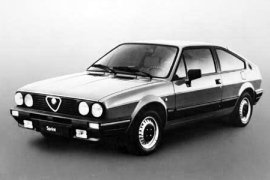ALFA ROMEO Sprint Models/Series Timeline, Specifications & Photos
First production year: 1976
Engines: Gasoline
Body style: Coupé (two-door)
After the introduction of the Alfa Sprint in 1976, in 1983 the Italian car-maker tried to improve the car. The German car-makers started to recover and increase its market share in the sport-compact segment.
In 1983 the Alfa Romeo Alfasud was out of the assembly line and it was replaced by the Alfa 33. Due to that, the Sprint, which relied on the Alfasud platform, had to be adapted for the evolved Alfa 33 one and that led to some modifications such as moving the front disc-brakes from inboard to the wheels, just like most of the cars on the market. The only downside was that the rear brakes were replaced with drums instead of the discs installed on the pre-facelifted model.
The shape remained the same one designed by Giorgetto Giugiaro but updated with plastic bumpers extended with an apron for the front one. There was a new grille design, with a smaller badge on the front. The rear-view mirrors were changed to improve visibility.
On the inside, the Recaro bucket-seats were standard-fit for the Quadrifoglio Verde (Cloverleaf). There was a new instrument cluster with new dials, but the information was the same: speedometer on the left, tachometer on the right, and in the upper-middle position the coolant temperature and the fuel level. Six more warning lights were placed between the two gauges.
From the technical point of view, the biggest improvement was for the engines, where the 105 hp QV version was introduced. The boxer engine led to a low center of gravity that ensured a good cornering speed. The former four-speed manual was ditched for a 5-speed. A 1.7-liter unit that offered 118 hp was introduced in 1987, replacing the 105 hp unit.
Alfa Romeo introduced the Alfasud Sprint in 1976 as an affordable sporty model primarily aimed at the European market, but the car ended up being sold on more continents between 1976 and 1988.
In the late ‘60s, the Italian government and Alfa Romeo inked a deal to open a factory in the Southern part of Italy to reduce the unemployment rate and increase the workforce’s skill level. As a result, in 1972, the Italian automaker started production, and the first car to be manufactured there was the Alfasud. Three years later, the second model emerged, and that was the station wagon Giardinetta. Then, in 1976, the Sprint followed and became a darling for every driver. Unfortunately, the car was produced in only one series that spanned twelve years and went through two facelifts, in 1978 and 1983, respectively.
The Sprint was penned by the Italian designer Giorgetto Giugiaro, and the car’s front fascia featured a pair of twin headlights mounted on the main grille. The Alfa Romeo shield took center stage and was adorned by a chromed trim. Under the grille, the automaker added a chromed metallic bumper, which sported the turn signals, and a black rubber stripe that protected it from minor scratches. Lower, under the bumper, the automaker added an apron that increased the car’s sporty look.
From its profile, the three-door hatchback vehicle boasted a sporty look with a raked windshield and a sloped-down tailgate. The wide side windows brought more light into the cabin, and the front ones featured a small fixed triangular glass area at the front. Giugiaro penned the car with flush door handles with chrome elements. On the C-posts, the designer added round elements that resembled the quatro-foglio (four-cloves) element specific for sporty Alfa Romeos. Finally, at the back, the Sprint featured high-mounted taillights on the rear fascia. Surprisingly, the rear window didn’t open with the vertical panel, and that technical solution contributed to lower production costs. In 1978, Alfa Romeo improved the model and added matte black mirror caps and C-pillar ornaments.
Inside, customers were spoiled with high-bolstered bucket seats at the front covered in fabric. A leatherette upholstery was also available. The driver fronted a squarish-looking instrument cluster where the automaker placed large round dials for the speedometer and the tachometer, while between them, the automaker added warning lights and gauges for the fuel level and the water temperature. The car didn’t come with a stereo as standard, but customers could opt for one. Alfa Romeo installed a fixed bench seat fit for three passengers in the back, although headroom was limited.
Under the hood, the 1976 Alfasud Sprint featured a flat-four engine with a 1.3-liter displacement, and customers complained about its performance. Then, in 1978, Alfa Romeo installed better engines for the sporty-looking car, including a 1.5-liter powerplant. All versions were paired with four-speed gearboxes that sent the torque to the front wheels.

